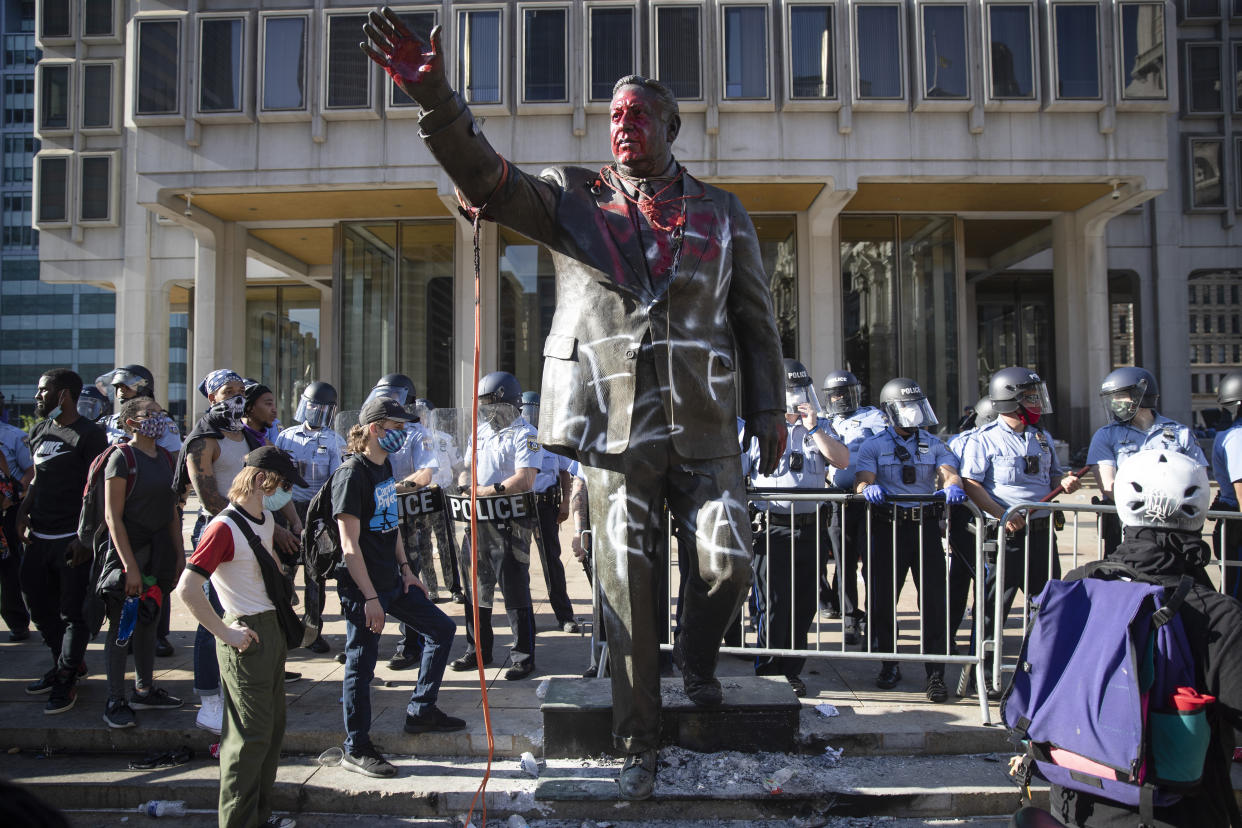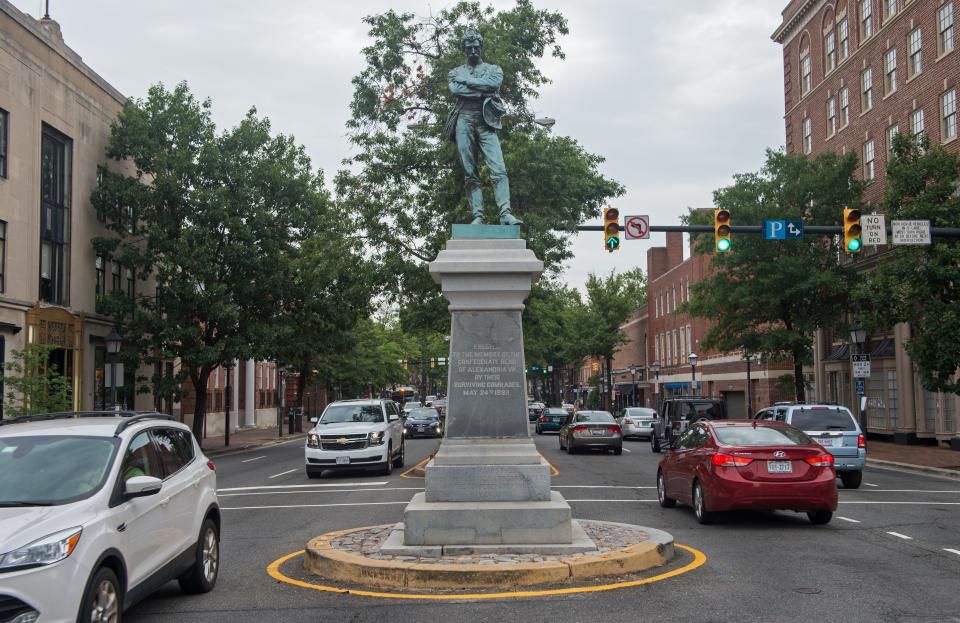Cities remove racist monuments before protesters can topple them

Early Wednesday morning, crews removed the statue of former Philadelphia mayor and police commissioner Frank Rizzo from its base near City Hall, a long-standing demand by activists and a step promised by the city in 2017. Over the weekend, demonstrators protesting the death of George Floyd had attempted to take down the statue on their own, vandalizing it in the process.
Rizzo remains a polarizing figure in the city, a tough-on-crime police commissioner in the 1960s and a tougher-on-crime mayor who campaigned by urging citizens to "vote white." During his time in City Hall in the 1970s, the U.S. Justice Department filed a lawsuit saying the city's police department’s use of excessive force “shocks the conscience.”
The statue, which was erected in 1998, “is a deplorable monument to racism, bigotry and police brutality for members of the black community, the LGBTQ community and many others. The treatment of these communities under Mr. Rizzo’s leadership was among the worst periods in Philadelphia’s history,” current Mayor Jim Kenney said in a written statement.
Since 2015, when a Confederate sympathizer killed nine people at a historic black church in Charleston, S.C., there has been a renewed push for the removal of Confederate iconography and monuments to historical figures and events viewed as racist, such as a mural of former President Woodrow Wilson at Princeton University. Wilson, a Democrat, held segregationist views. In the current wave of demonstrations, some communities have attempted to preempt protesters by removing these symbols, as millions push for the nation to address its history of systemically oppressing people of color.
Protesters gathered in Birmingham, Ala., on Sunday and attempted to tear down the Confederate Soldiers & Sailors Monument, a 52-foot-tall obelisk in Linn Park. The park is named after Charles Linn, a captain in the Confederate Navy. While protesters were unable to destroy the Soldiers & Sailors Monument, they did tear down a statue of Linn, spray-painting it before pulling it down with ropes.
Birmingham Mayor Randall Woodfin has been in a struggle with the state over his attempts to remove the Soldiers & Sailors Monument. Some states, with majority-white legislatures, have passed historical preservation laws in an attempt to stop majority-black communities, like Birmingham, from removing Confederate memorials. Woodfin ordered the statue taken down in an attempt to ease tensions in the city, with the state attorney general saying it would issue a one-time $25,000 fine. On Monday, the statue was removed.
“In order to prevent more civil unrest, it is very imperative that we remove this statue,” said Woodfin. “I understand the AG’s office can bring a civil suit against the city, and if there’s a judgment rendered from a judge then we should be held accountable, and I am willing to accept that because that is a lower cost than civil unrest in our city.”
Protesters in Huntsville, Ala., gathered Monday to demand the removal of a Confederate statue in the downtown area. A local business group responsible for developing the area issued a statement asking the city to act.
“The tragic killing of George Floyd has magnified the deep pain experienced by African-American and other members of our community,” the trade group Downtown Huntsville said in a statement. “We are heartbroken by this pain and believe a true path toward healing requires more than words of reconciliation or statements of empathy and support.
“Rather, this path toward understanding and healing requires specific actions to directly advance this critical process. Today, we advocate that one such step should be the removal and relocation of the Confederate Memorial from the Downtown Huntsville Courthouse Square to a historically contextual location that would allow our community to learn from the great pain that this memorial represents while also removing it from our community’s courthouse grounds.”

Officials in Alexandria, Va., accelerated the removal of a Confederate monument that was scheduled to be taken down next month. The city removed the statue of a Confederate soldier that has stood in an intersection for 131 years on Tuesday after Mayor Justin Wilson came to an agreement with the United Daughters of the Confederacy to avoid vandalism or damage. The city had been trying to remove the statue from its prominent location for years but was blocked by a state law. The law was recently amended by a new Democratic majority in the state Legislature.
“Alexandria, like all great cities, is constantly changing and evolving,” said Wilson in a tweet that included images of a crew removing the statue.
Vandals targeted a range of Confederate statues in the former secessionist capital of Richmond, Va., on Saturday evening. A massive statue of Gen. Robert E. Lee on a main thoroughfare was tagged with graffiti reading “No More White Supremacy,” “Blood on Your Hands” and “Black Lives Matter.” A statue of Jefferson Davis, the Confederate president, was defaced and had a noose hung from it. On Wednesday afternoon, the Associated Press reported that Virginia Gov. Ralph Northam was going to announce the removal of the Lee statue. Vandals set fire to the headquarters of the United Daughters of the Confederacy, but the blaze was extinguished by local firefighters.
Confederate monuments were also defaced in Oxford, Miss., Raleigh, N.C., and Charleston, S.C.
As for the Rizzo statue, the Philadelphia Inquirer reported that the city said it is being placed in secure storage by the Department of Public Property “until a plan is developed to donate, relocate, or otherwise dispose of it.” A Rizzo mural in South Philadelphia was vandalized Wednesday morning, and the organization that maintains the mural announced it would cease all involvement, including restoration and repairs.
_____
Read more:



